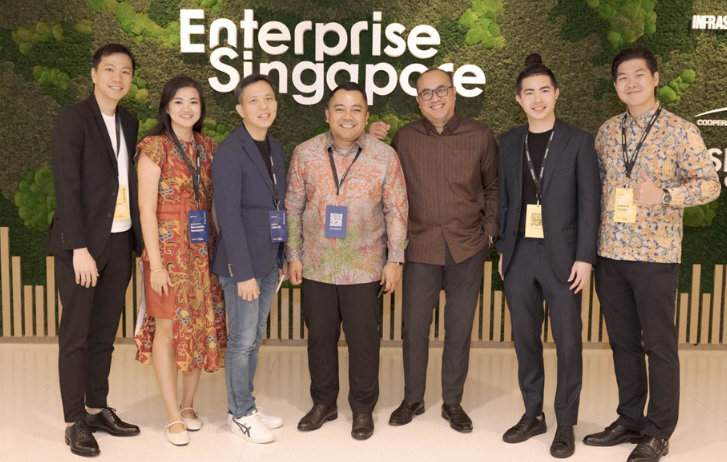
How Louken’s CEO Helps APAC Brands Transform Digitally And Go Global
By FedEx | November 15, 2024
Lee Haoming is the CEO of Louken, a Singaporean venture builder delivering digital transformation and more for SMEs and large enterprises. He reflects on the company’s ‘disrupting with passion’ philosophy – and what it takes to be a springboard for small businesses who make it big.
- Louken is a Singapore-based ‘venture-building’ service helping companies navigate industry unknowns and develop winning business concepts.
- Venture builders like Louken are part of a new wave of consultancy-based B2B businesses using digitalization to drive SME growth.
- Recently appointed CEO Lee Haoming dives into what it takes to get businesses to the top of their game.
Today’s entrepreneurs are increasingly likely to start businesses in tech, software, or digital services. With most consumers – and companies – relying on an ever-evolving tech stack to take care of admin, organization, and operational tasks, digital solutions are more in demand than ever.
Tools and platforms that solve key customer pain points or simplify manual or complex processes are transforming how we live and work. Louken is a venture builder that specializes in business growth with services that include brand and digital transformation.
Louken CEO Lee Haoming, the former managing partner of Huggs Coffee, joined the Singapore-based company in 2023 to refocus Louken’s product offering and help SMEs expand globally.
We spoke with the Prestige 40 under 40 honoree about what it means to be a venture builder, the ideal tech stack for businesses with ambition, and why it’s okay to say no to opportunities that distract you from achieving your goals.
As CEO of Louken Group, you help companies transform digitally and go global. What’s been the most unexpected lesson you’ve learned so far?
Lee Haoming: Since taking on my current role, I’ve discovered that digital transformation goes far beyond adopting new technologies. It’s fundamentally about people and culture. Digital transformation lives or dies based on a company’s internal mindset. You can’t just impose new technologies on a team that isn’t mentally and emotionally prepared for change.
The human factor is, without a doubt, the most critical element in any digital transformation journey.
Leaders and employees need to adopt a culture of agility and curiosity, and be open to new ways of doing things. Without that shift, even the most sophisticated tech investments will fail to deliver real value.
The strongest brands are those with a clear sense of purpose, internally and externally. Once there’s alignment between brand, culture, and strategy, you’re much more likely to thrive in a digital environment and scale successfully in global markets. The human factor is, without a doubt, the most critical element in any digital transformation journey.
What’s the first thing a business should do before embarking on a digital transformation journey?
The very first step in any digital transformation is getting the leadership team aligned on a shared vision. Once leadership is on the same page, the next step is to conduct a full audit of current processes, systems, and digital capabilities. This audit helps identify inefficiencies and pinpoint where digital tools can make the most impact.
It’s important to manage expectations from the start. Digital transformation is a continuous journey, not a one-time project. By focusing on areas that deliver immediate results - like automation or process optimization - companies can build momentum and confidence.
Once foundational improvements are in place, it’s easier to scale more complex initiatives like AI, big data, or advanced analytics.
How do you assess a company’s readiness for digital transformation?
First, leadership must be fully committed and aligned on the goals and outcomes of transformation. Otherwise, the transformation process often falls apart before it even begins.
Second, we look at company culture. Are employees open to new ideas and processes, or is there resistance to change? Digital transformation is only as successful as the people who drive it, so cultural readiness is key.
Finally, we assess the existing technology stack. Most legacy systems aren’t designed to integrate with newer digital solutions. This creates major roadblocks. We check whether the infrastructure is scalable and flexible enough to support the transformation.
If any of these areas - leadership, culture, or technology - are lacking, we work with the company to address those gaps before moving forward. This sets a business up for long-term success, not just short-term fixes.
How do you tailor internationalization strategies for each company you work with?
When we help businesses expand internationally, we never take a one-size-fits-all approach. The first step is always a deep dive into the client’s business. We take time to understand their products or services, current market positioning, and what they hope to achieve through internationalization. This analysis helps us identify which parts of the business model need to be adjusted for new markets.
Next, we conduct comprehensive market research to validate the potential of different regions. We use it to define a clear internationalization roadmap, outlining everything from market entry strategies to long-term growth plans.
We don’t stop there. Strategic partnerships are key. Local partners provide invaluable insights into consumer behavior, regulatory requirements, and market trends. They help us craft a more effective strategy.
Industry and company differences also play a critical role. A retail brand might focus heavily on customer experience and logistics, while a tech company will prioritize digital infrastructure and compliance with local regulations. Larger companies can leverage existing brand equity when scaling internationally, but smaller businesses may need to localize their offerings to resonate with new markets.
With the rapid pace of digital disruption, how can companies stay competitive without biting off more than they can chew?
Companies have to strike a balance between adopting new technologies and staying focused on their core strengths. I often see businesses getting swept up in the latest tech trends, eager to be on the cutting edge. But in doing so, they risk stretching their resources too thin or implementing technologies that don’t truly serve their goals.
To remain competitive, companies need to take a strategic, phased approach to digital adoption. Instead of trying to do everything at once, start by identifying areas where digital tools can make an immediate, significant impact.
The key is to ensure these technologies are aligned with the company’s long-term vision, rather than adopting them simply because they’re trending.
Automation, for instance, is the ideal entry point. It frees up resources, allowing teams to focus on higher-level strategic initiatives. Once that foundation is in place, more advanced tools - like AI, machine learning, or big data analytics - can be layered on to drive further growth.
The key is to ensure these technologies are aligned with the company’s long-term vision, rather than adopting them simply because they’re trending. This approach allows companies to remain agile and innovative without overcommitting to tools or strategies that might not be sustainable. Ultimately, the goal is to remain flexible and responsive to market changes while keeping a clear focus on what truly adds value.
What are the most common cultural challenges for companies that want to expand internationally?
Expanding into new markets is not just a matter of logistics or strategy. It’s about understanding and respecting cultural differences.
It’s easy to assume that what works in one country will work everywhere, but that’s rarely the case. A marketing campaign that resonates with customers in Singapore might completely miss the mark in the US, China, or even neighboring markets like Indonesia.
To address this, we take a ‘glocalization’ approach - keeping the core essence of the brand intact while adapting specific elements like messaging, packaging, and customer service to fit the local culture.
It’s not just about translating words; it’s about understanding the values, behaviors, and expectations of local audiences. Our local partners supply on-the-ground insights into consumer preferences and regulatory landscapes. It’s a delicate balancing act, but when done right, your brand can resonate with customers around the world.
Is there one belief you have that other business leaders might disagree with you on?
I strongly believe that saying “no” to certain opportunities can be more important than saying “yes.” Early in my career, I thought that every growth opportunity should be pursued. I quickly learned that this approach leads to overextension and burnout.
Today, I advocate for a more selective approach to growth. Not every market is the right fit for every brand, and not every product idea is worth pursuing. It’s important to focus on what aligns with your long-term vision and core strengths. Don’t chase growth for growth’s sake.
Yes, this goes against the conventional wisdom of always striving for more, but I’ve seen firsthand how it leads to better, more sustainable success. By being selective, companies can allocate resources more effectively, build stronger brand equity, and ultimately achieve more meaningful growth. In a world where “more” is often synonymous with “better,” I believe in the power of focus and restraint.
What’s the greatest business failure you treasure the most?
One of my most valuable failures came when I co-founded Artbox Singapore. Although the event eventually became a major success, drawing over 700,000 visitors, the first attempt was riddled with challenges.
We underestimated the complexity of managing such a large-scale event, and it quickly became clear that we weren’t fully prepared for the logistical and operational issues that came our way. From crowd control to vendor management, everything was a learning curve.
While it was a stressful experience, it taught me the importance of meticulous planning and operational excellence. No matter how exciting or innovative a project is, the details matter.
The experience also reinforced the importance of being flexible and adaptable in the face of challenges. Failure is inevitable, but how you respond to it ultimately defines your success. That experience at Artbox became one of the most formative influences on my approach to leadership and strategic planning at Louken. I always say: “In life, there’s no loss when you try - only win or learn.”
***
Our Confessions of a CEO column quizzes Asia Pacific leaders on business insights that aspiring entrepreneurs can learn from. To discover more entrepreneurship stories like Haoming’s, subscribe to our monthly newsletter below, and stay tuned for the next edition.
SHARE THIS STORY
- Generative AI: A New Frontier
- How To Ship A Giant Panda
- How To Make Freight Shipments Work For Your Small Business
- The Rise Of Intra-Asia Trade: Opportunities In The China-Southeast Asia Corridor
- Where Do Old Planes Go When They Retire?
- What’s So Dangerous About Coconuts? Your Guide To Dangerous Goods Logistics
Sign up now and save on your shipping rates!
Sign up now and earn discounts by shipping instantly with FedEx Ship ManagerTM at fedex.com.
Recommended For You

The APAC CEO Transforming How Businesses Harness Data
Karen Kim’s cloud data platform, Human Managed, equips enterprises with the data intelligence they need to operate more efficiently.
Read More
Plinkit’s CEO Is On A Mission To Make Parenting Simpler
Charmaine Pattinson is the CEO of Plinkit, a leading online child development resource for intentional parents and educators.
Read More
How Terrascope's CEO Is Reshaping The Path To Net-Zero
Emissions measurement & management platform Terrascope shares climate insights with companies aiming to reach net zero for a more sustainable future.
Read More





